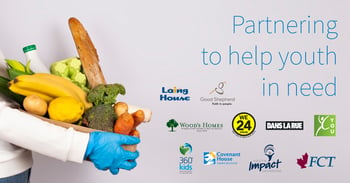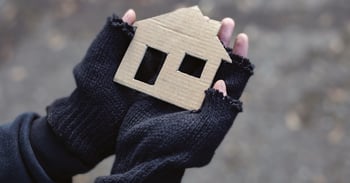
Did you know that across Canada, there are an estimated 40,000 youth currently experiencing homelessness? Around 40% of them will have first experienced it before they were 16. Many are part of the “hidden homeless” population—staying temporarily with friends or relatives, with no permanent, stable shelter.
At FCT, we’re invested in our community. That’s why we’re dedicated to helping its most vulnerable members, with the help of our community partners. In addition to FCT’s volunteering partners, we work with several local organizations providing aid to at-risk and unhoused youth in communities across the country.
We spoke to a few of our partners about the misconceptions around youth homelessness they encounter in their work, and what they wished more people knew. Here’s what they had to say:
360° Kids’s Bonnie Harkness: youth aren’t choosing homelessness
“There are so many ways kids can find themselves in homelessness. Kids can lose their housing by family breakdown, or a mental health crisis can easily become a housing crisis. Maybe they’re not showing up to work because they’re in depression and literally cannot get out of bed. They lose their job and now they can’t pay their rent, so they lose their home.
| “It affects their social life. They stop being themselves—they’re more agitated, fighting with friends and sabotaging relationships, so their network erodes as well.” |
“You may have a young person who identifies as LGBTQ, and who comes out to their parents, or the parents find out. There’s a family breakdown and the young person is kicked out of the house. This could be someone who’s getting 90s in school, playing in the band, who never had any problems with addiction or mental health, who now finds themselves on the street with nowhere to go, no resources.
“There’s a trickle-down effect: kids start not going to school because of everything they’re managing. There’s nowhere for the school to contact because they’re not living at home, so it’s that much harder to correct their grades as they start to slip. It affects their social life. They stop being themselves—they’re more agitated, fighting with friends and sabotaging relationships, so their network erodes as well.”
Covenant House Vancouver’s Alison Brodie: youth can’t “just get a job” to get off the street
“Most people aren’t aware that a huge proportion of the youth homeless population aren’t necessarily on the street. [In Vancouver] as in many other cities in Canada, homelessness is such a visible issue—the average person here encounters someone experiencing homelessness daily.
| “The idea that if you pull yourself up by your bootstraps and get a job and work hard, that everything will fall into place is just false.” |
“Lots of youth in this situation are staying with friends, they’re couch surfing, staying with other family members. They are homeless—they don’t have a safe and consistent place to stay—but they’re not the people you see on the street. They could be working at Starbucks or the grocery store.
“Homelessness is a very complicated issue. There’s no one cause, no single contributor to why people are remaining homeless. The idea that if you pull yourself up by your bootstraps and get a job and work hard, that everything will fall into place is just false.
“So many of the youth we see [at Covenant House] are working. They’re making minimum wage and they’re working so hard, they’re just not making enough money to make rent. Thinking you can just work hard and lift yourself out of homelessness overlooks all the structural and systemic factors.
“We often say homelessness is the least interesting thing about the youth that we work with. So many of them have gone on to do incredible, impressive things. Right now, they’re in a challenging spot in our lives, and a lot of us can relate to that.”
Laing House’s Colin Bullard: helping at-risk youth means fighting mental health stigma
“Some of our members are working through serious mental health issues like schizophrenia and even psychosis. They’ve have had to deal with the assumptions that come with their diagnosis: that they can’t think for themselves, that they’re irrational or that they need to be monitored at all times.
“Stigma like that can force people to hide what they’re struggling with or risk people in their lives distancing themselves. They might not get hired for a job, or may even get denied housing.
| “Breaking stigma comes down to trust, openness and honesty. Our members are just regular people finding themselves at a difficult age and time.” |
“At Laing House, we try to provide a place where that stigma does not exist and can’t hurt their ability to recover. The key is to make it feel normal to talk about mental health, which is a challenge even in normal circumstances.
“Breaking stigma comes down to trust, openness and honesty. Our members are just regular people finding themselves at a difficult age and time. They need help, but they’re still sociable, approachable people. Helping our members see themselves for who they are and not how they’ve been diagnosed is the first step. Helping the public see it is the second.”
Woods Homes’s Corinne Nelson: pushing support away can be a cry for help
“We teach our staff, as well as our children, that they can make mistakes. Our practice is about building relationships through leadership and forgiveness.
| “We call it “pain-based behaviour.” They think they’re not worth the relationship, so they try to sabotage it.” |
“Many of our young people have been mistreated, and have learned hard lessons early on. It’s common for them to re-enact those lessons in their own lives. It can lead them to lash out at people close to them or push them away. We call it “pain-based behaviour.” They think they’re not worth the relationship, so they try to sabotage it.
“That’s where forgiveness comes in and helps break that cycle. We’re not a “one strike, you’re out” type of organization. We’ve had so many kids come to us still in that pain-based mental space, who think “I’m going to break this placement down and you’re going to kick me out.” But we’re going to be there for them, again and again.
“Forgiveness creates the space to teach our kids how to reconcile what they’ve experienced. Forgiving themselves can become forgiving others.”
How can I help youth experiencing homelessness in my community?
Donations of clothing, food and other material aid are vital for supporting at-risk youth and those without reliable housing. But your time and knowledge can be just as important to donate—teaching youth life skills and proving to them they can rely on others. Find out what local programs are available in your area, and which are looking for resources or volunteers.
If you live in one of these communities, please consider supporting our partner there:
Oakville, Ontario: 360° Kids
Vancouver, B.C.: Covenant House Vancouver
Calgary, Alberta: Woods Homes
Halifax, Nova Scotia: Laing House
Montreal, Quebec: Dans La Rue
London, Ontario: YOU London
Moncton, New Brunswick: Youth Impact Jeunesse
®Registered Trademark of First American Financial Corporation.

























